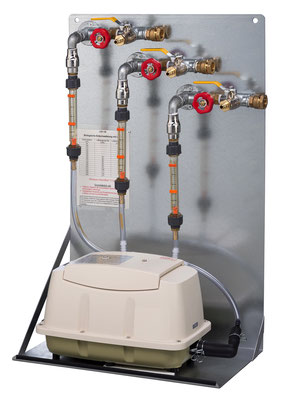hydrogen sulfide (H2S) REMOVAL
Hydrogen sulfide is a colorless gas that creates a blue flame when burned and a toxic gas, sulfur dioxide (SO2). H2S in a concentration of 10 parts per million (ppm) can be distinguished by smell. The density of H2S gas is 1,192 kg / m3 higher than that of air and due to its weight it settles on the ground. The hydrogen sulphide contained in biogas causes odours, corrosiveness, and sulphur emissions when the gas is burned. If the biogas is to be used in internal combustion engines, turbines or fuel cells, the removal of hydrogen sulphide from the biogas may be required to protect the equipment and avoid damages. Hydrogen sulfide is flammable, smells like rotten eggs, has a sweet taste and is noticeable at concentrations of 0.002 mg / l. However, in concentrations greater than 500 ppm it affects the ability of the olfactory nerve to perceive and thus prevents its detection through this sense, making it more dangerous.
The biogas contains hydrogen sulfide (H2S) in ranges from 500 to 5,000 ppm, which can reach 2% by volume or more. It is important to reduce H2S to avoid corrosion damage to biogas recovery equipment. Electricity generators generally require a biogas with an H2S content of maximum 100 ppm. The hydrogen sulphide must be removed to avoid any corrosion in parts of the plant. The removal also protects catalysts which are used from an impact by sulphur containing compounds and a subsequent deactivation.
Hydrogen sulphide (H2S) is always present in biogas. The concentrations vary with the feedstock. The concentration of hydrogen sulphide in the biogas is a function of the digester feed substrate and inorganic sulphate content. Wastes which are high in proteins containing sulphur-based amino acids (methionine and cysteine) can significantly influence biogas hydrogen sulphide levels.
HYDROGEN SULPHIDE REMOVAL TECHNIQUES
Hydrogen sulphide can be removed from biogas by activated carbon. The selection of the filter size and the related activated carbon type depends on the chemical composition of the biogas as well as on the physical parameters such as humidity and temperature.
Air dosing unit
Sulphur in biogas causes problems during combustion in the CHP. Desulphurization is useful. Using an air dosing unit it is possible to feed small amounts of oxygen into the digester tank.
Desulphurization of biogas takes place within the digester through the activity of naturally occurring bacteria that use the hydrogen sulphide in their metabolism and deposit elemental sulphur. They need a small amount of oxygen. To this end an air pump blows a small amount of air into the gas space in the digester. The amount of air should be about 4-6% of the amount of gas produced.
The full effect of desulphurization is attained after several weeks, when a gas biofilm of hydrogen sulfide consuming bacteria is formed on the surfaces. This is facilitated by higher temperatures, wetting the surfaces with slurry/substrate by rough surfaces.
Part of the air dosing unit
Air pump for continuous operation
Air flowmeter device
Throttling valve to regulate the volume
Connection with ball valve for condensate drainage and pipe rinsing
Air nozzle with non-return valve
Dimensions
Type 20 for amounts of air up to 20 l/min
Type 40 for air amounts up to 40 l/min
Type 120 for air amounts up to 120 l/min
The indicated air quantities apply for pressure drop in the air pipes to the air nozzles of max 10 mbar and gas pressure maximum of 10 mbar in the digester.
BIOLOGICAL H2S REMOVAL






